Brazil
Coffee first arrived in Brazil in the 18th century, but ever since the French first brought it, it has become a much-loved national beverage and a major export, with Brazil exporting a third of the world’s coffee. It is known for its mild sweetness, nutty flavor and relatively low acidity. Brazilian coffees, which include both Arabica and Robusta, bear the name Santos, named for the port where coffee was traditionally shipped off to around the world. Brazil’s mild climate is well suited for coffee growth, and there are a number of different regions, which grow coffee beans reflecting the environment of that part of the country.
Minas Gerais
Minas Gerais is the region with the largest coffee output, exporting about 50% of the country’s coffee. This region consists of the following:
- Sul de Minas is an area of high altitude and mild weather, with most of the coffee produced on small farms.
- Cerrado de Minas is a large area with humid summers and dry winters, known for their specialty coffees.
- Chapada de Minas is a highland region with valleys, producing a unique coffee bean.
- Matas de Minas has a warm and humid climate and most coffee beans are produced on small farms.
São Paulo
São Paulo is the traditional coffee growing region of Brazil and is also home to the Santos port where coffee is exported around the world. This region includes:
- Mogiana is known for an ideal altitude, mild weather and uneven terrain which contributes to its good quality coffee.
- Centro-Oeste de São Paulo is a hilly region with uneven terrain, consisting of mostly smaller sized farms.
Espírito Santo
Espírito Santo is Brazil’s second largest coffee bean growing region, growing mostly Robusta coffee. The regions include:
- Montanhas do Espírito Santo is a highland area with mild weather.
- Conilon Capixaba grows Conilon which is Robusta coffee. It is grown on low altitudes and on smaller farms.
Bahia
The northeastern region of Bahia is known growing 75% Arabica coffee. The regions are:
- Cerrado and Planalto da Bahia are high tech coffee producing regions, with mild weather and a high altitude.
- Atlantico Baiano produces Robusta on small farms at low altitudes.
Parana
Parana is an exclusively Arabica growing region known for dense and productive coffee plantations.
Rondonia
Rondonia exclusively grows Robusta and is known for its tropical climate, with high temperatures and low altitudes.
Get in touch with us
Drop us a line to get more information about our coffees.
